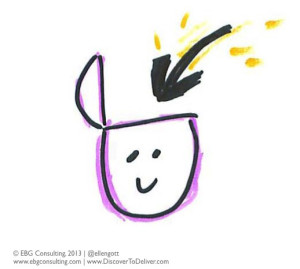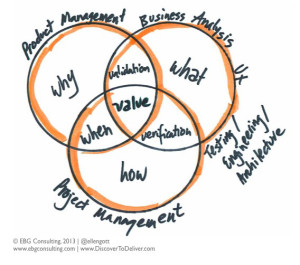Insights and Takeaways: Agile Topics at Project World/World Congress for Business Analysis
By Ellen Gottesdiener
 For the past several years, I have had the privilege of chairing the Agile Summit portion of the Project World/World Congress for Business Analysts. I hope you were able to join us last month in Orlando. This year, we had a tremendous turnout and enjoyed our time learning and networking with each other.
For the past several years, I have had the privilege of chairing the Agile Summit portion of the Project World/World Congress for Business Analysts. I hope you were able to join us last month in Orlando. This year, we had a tremendous turnout and enjoyed our time learning and networking with each other.
I’ve had several requests for a summary of my half-day tutorial with Ainsley Nies, “An Agile Approach to Project and Products” as well as the Agile Summit presentation “Got Value? A Practical, Sustainable Value Model for Making Agile Product Decisions” and the track session I gave: “It’s the Goal, Not the Role: The Work of Agile Project Management and Business Analysis.” I wrote up a quick synopsis of all three, along with some suggestions that you can try in your next planning or retrospective session.
If you’d like to see either of these talks in person or have a workshop delivered to your team or business, please let me know.
Tutorial Summary
“An Agile Approach to Projects and Products: The Who, What, and Why”
with Ellen Gottesdiener and Ainsley Nies
Primary Insights:
Doing agile is not the same as being agile. Doing agile is about the practices. Being agile is about living and acting on agile values and principles. Being agile requires practice, time and continual—and transparent—feedback.
Key Takeaways:
- Agile approaches challenge paradigms around management focus, culture, change, measuring success, design, and value. Know your comfort level along the gradient of traditional (waterfall) and agile methods.
- Being agile is more of a mindset than a method. It is reinforced by values and principles that guide behavior and enable success in an environment of rapid change and uncertainty.
- You cannot be agile unless you are continually pausing to reflect—honestly—about your progress, impediments, puzzles, challenges, and joys.
- Doing and being agile collapses the cone of uncertainty.
At the end of the half-day tutorial, each participant left with a personal development plan for being agile and doing agile. If you and your team don’t currently have a personal development plan for both doing agile and being agile, consider creating one in your next retrospective.
Agile Summit Presentation
“Got Value? A Practical, Sustainable Value Model for Making Agile Product Decisions”
with Ellen Gottesdiener
Primary Insights:
Value is the agile mantra. Yet too many agile teams fail to explore and periodically reassess what value really means for their projects. A product delivers value when it provides a fair return—in goods, services, time, or money. Different stakeholders—those who act as product partners to discover and deliver a high-value product—have different perceptions of value. Making optimum value-based decisions about what to deliver, and when, means you need to holistically understand and balance the value considerations of all the product partners.
Key Takeaways:
- Value is in the eyes of the beholder, so know your beholders—your customer, business, and technology product partners.
- Explore your product partners’ value considerations.
- Value changes with time, so revisit it at each planning horizon (the Big-View, Pre-View, and Now-View)
- You need your vision, goals, and quantifiable objectives as the basis for your “ends.”
- Value is not just about money. Value can include less tangible things such as convenience, branding, ease of support, time to market and more.
- Validate your assumptions about value—determine if what you delivered actually did achieve value—after each delivery cycle.
- Ensure decision-making rules and processes are clear and transparent.
When was the last time you purposefully validated your value assumptions? Take some time in your next planning or retrospective session to talk honestly and transparently about delivering value.
Track Talk
 “It’s the Goal, Not the Role: The Work of Agile Project Management and Business Analysis”
“It’s the Goal, Not the Role: The Work of Agile Project Management and Business Analysis”
with Ellen Gottesdiener
Primary Insights:
To align with the 12 principles of the agile manifesto, the work of agile project management, product management, and business analysis in agile must deviate from traditional practices in timing, breadth and depth. Even though some agile project management, product management and business analysis skills overlap, the attitudes and aptitudes of the agile mindset do differ.
Key Takeaways:
- It’s about the work, not the role or title.
- Focus more on the disciplines of agile business analysis, agile project management, and agile product management. Each requires skills (that sometimes overlap).
- Agile project management and analysis share the need for excellent skills in communication, collaborating, decision, negotiating, facilitation, and team building.
- Agile project management focuses on visualizing the work, while agile business analysis focused on visualizing the product. Agile project management focuses on project constraints, while agile business analysis focuses on product scope. Agile project management stands back to deliver, while agile analysis collaborates to discover.
- The discipline of agile product management is essential for success. Build those competencies. Product management is often misunderstood and underserved in many organizations.
- Seek “square teams” and “T-shaped” people. T-shaped” people are those with depth of skills in one area as well as breadth of skills across multiple areas. Square teams are made up of “T-shaped” people, forming a solid square in both depth and breadth in all the skills the teams needs.
References:
Ambler, Scott, “Generalizing Specialists: Improving Your IT Career Skills.”
Gottesdiener, Ellen and Mary Gorman. Discover to Deliver: Agile Product Planning and Analysis, EBG Consulting, 2012.
Gottesdiener, Ellen and Mary Gorman, “It’s the Goal, Not the Role: The Value of Business Analysis in Scrum.”
Hansen, Morten and Tim Brown, “IDEO CEO Tim Brown: T-Shaped Stars: The Backbone of IDEO’s Collaborative Culture.”
Heuer, Sean, “Building Square-Shaped Teams With T-Shaped People.”

[…] The Venn of Disciplines, as presented at Project World/World Congress for Business Analysts […]